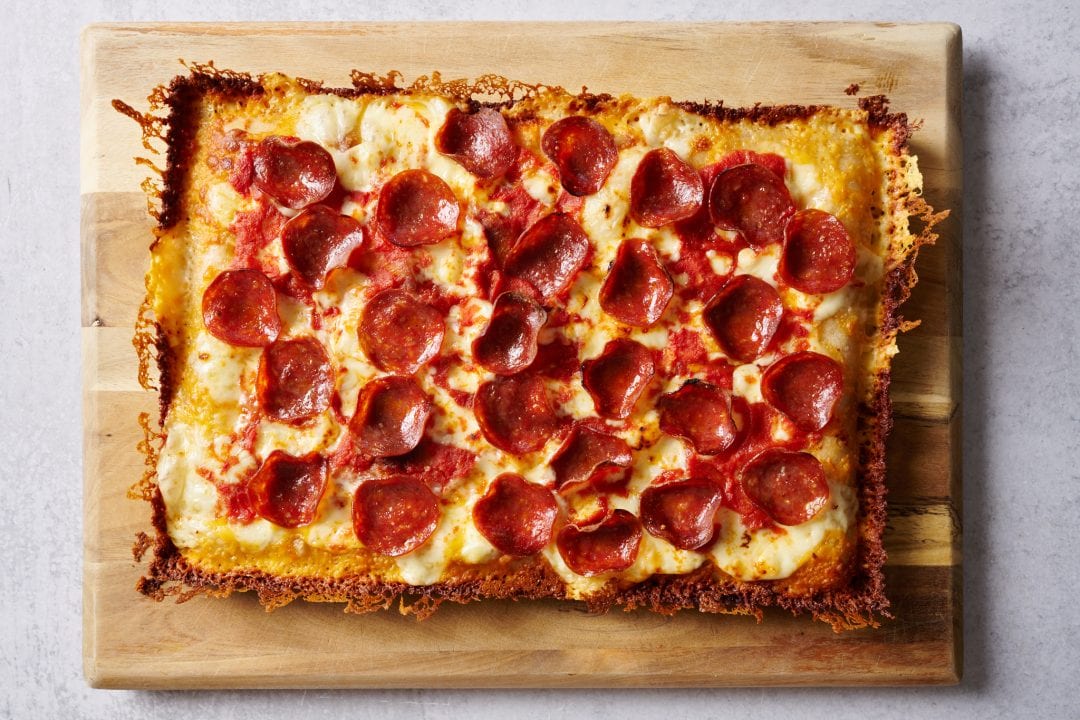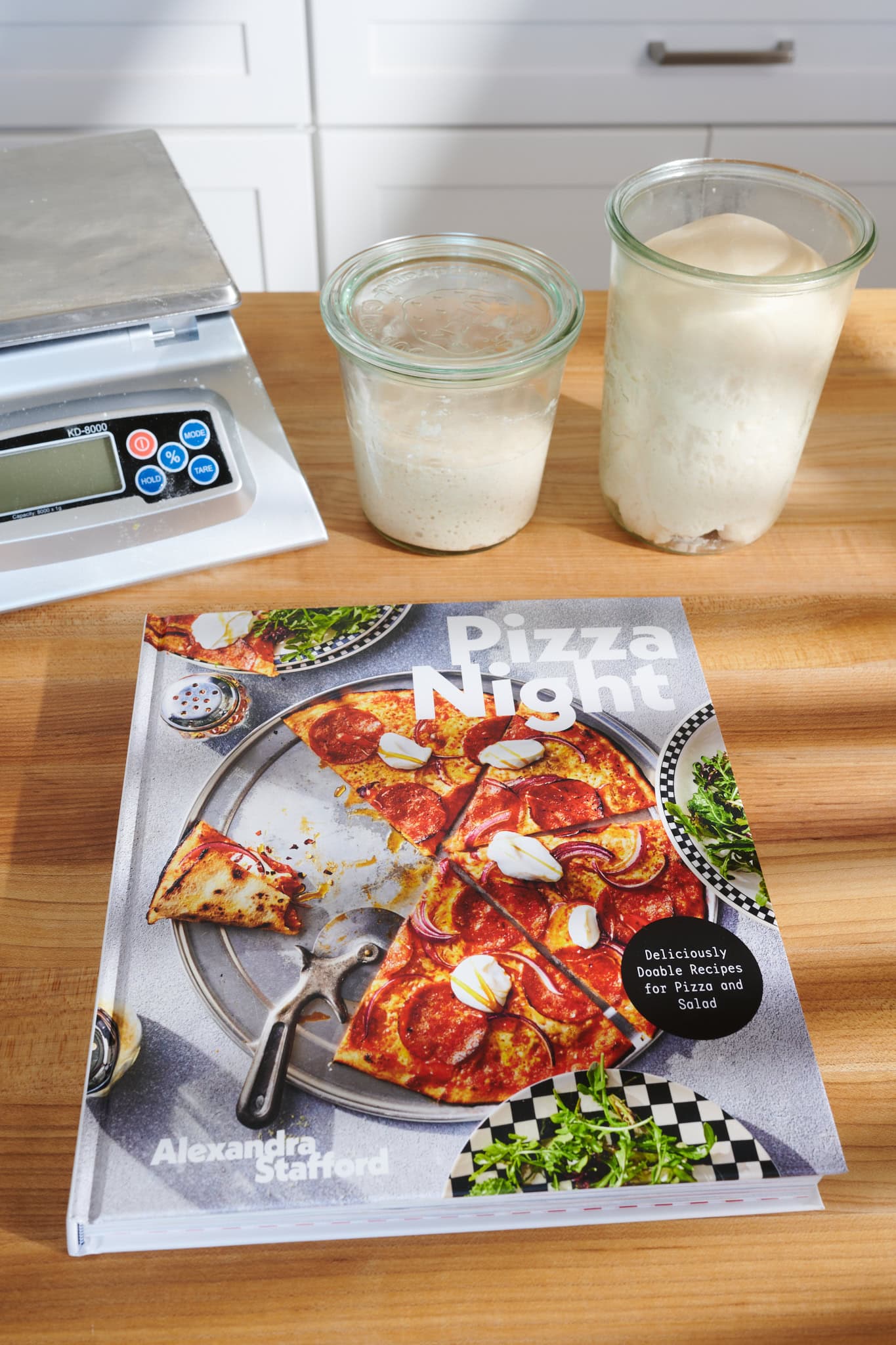As the cheese sizzled and the singed pepperoni crackled, immense joy spread across my face. Pulling this rectangular cheesy slab from the oven might have been the best thing I did the entire week. The crispy lacework edge stood tall like trees along a thin forest perimeter, a border of crunchy, cheesy deliciousness. And that was just the beginning.
For a long while, I’ve considered making a proper Detroit-style pizza. Finally, the right motivation arrived this past week in the form of Alexandra’s latest cookbook, Pizza Night: Deliciously Doable Recipes for Pizza and Salad. Over the past week, I’ve flipped through it, oohing and ahhing on just about every page. Her book is brilliant; it pairs often-cheesy and often-savory pizza with an often-overlooked yet almost mandatory light counterpart: salad.
These salads—not just average weeknight salads, mind you—keep the meal light and palate varied. But what’s more, they could be an entire meal on their own if pizza wasn’t served alongside. In fact, many of these salads are so standout that I could even—gasp—save the pizza for later and gobble up the entire salad without a cheesy distraction.
But today, we’re here for pizza. I mean, just look at this (and the excitement on my face):
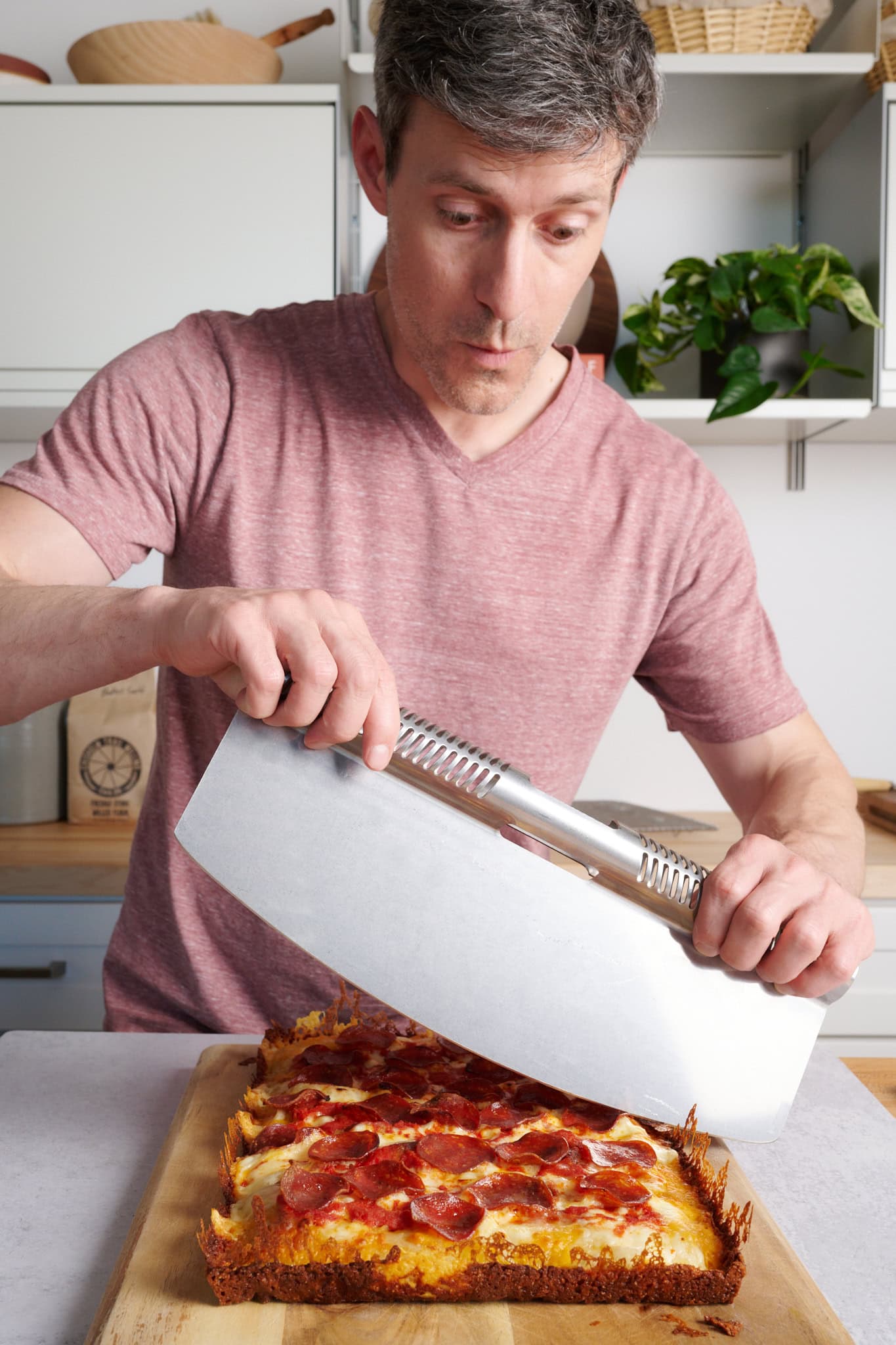
Buckle up, we’re about to take an exciting drive to Detroit.
Real Quick: Why I Like This Detroit-Style Pepperoni Pizza:
- Easy dough prep: The dough uses a single flour type and can be mixed by hand or in a stand mixer
- Flexible schedule: You can mix the dough in the morning and make pizza that night or refrigerate it for 1 to 3 days
- Crowd pleaser: A pan pizza is easier to make when feeding guests; you bake it once, and everyone eats at the same time
- Top it with what you got: I love pepperoni on this pizza, but feel free to go with sausage, peppers, bacon—whatever you have in the fridge!
- Use your sourdough starter: there’s no need to make a dedicated levain for this pizza dough. Use your ripe sourdough starter
More About The Pizza Night Cookbook
I’ve been a fan of Alexandra’s for years. Her website, Alexandra’s Kitchen, is a tour de force, an extensive collection of successful recipes for every occasion and every mood. What I love most about her style, though, is that she’s thoughtful and detailed, never leaving readers wanting more explanation—and her new cookbook is no different.
The book starts with various doughs for different pizza styles: Neapolitan pizza, pan pizza, and even gluten-free pizza. Then, with these doughs in the toolbelt, she provides an arsenal of sauces, toppings, and dressings to spice things up. Further, her book is divided into seasons, giving convenient inspiration for seasonal cravings and vegetable availability. I just love her book, and I think you will too.
Watch Me Make This Detroit-Style Pizza
I’ll take you from start to finish in this quick YouTube short. Look at that cheesy crunch!
In this post, I’m going to dig into the various components of making a Detroit-style pizza:
But first, what exactly is Detroit-style pizza anyway?
What is Detroit-Style Pizza?
Detroit-style pizza hails from Detroit, Michigan, and is rectangular in shape and baked in a steel pan. The pizza is thick, chewy, and loaded with cheese—often Wisconsin brick cheese. When preparing this pizza, cheese is placed first on the dough (which can be parbaked) and spread all the way to the edge of the pan, resulting in an incredibly crisp and caramelized cheesy crust (a “frico” crust). After the cheese is added, toppings are usually next followed by dollops of tomato sauce.
In my book, crispy pepperoni is the only way to pepperoni.
In testing this recipe, I followed Alexandra’s advice and played with the topping order just a bit, adding the pepperoni last to the top of the pizza stack. Yes, this is a small break in tradition, but as she says, and I completely agree, by adding them last, you get crispy pepperoni edges. In my book, crispy pepperoni is the only way to pepperoni.
Pizza Thickness: Detroit-style versus Sicilian versus Grandma
There’s often confusion between the various square and rectangular styles of pizza. Generally, Sicilian (or even Roman style, or pizza al taglio) is the thinnest, followed by Detroit, Grandma, and Chicago deep dish.
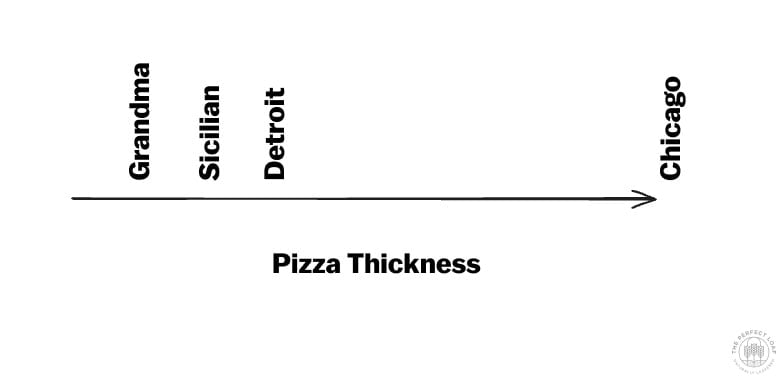
Detroit-Style Pizza Flour Selection
One of Detroit-style pizza’s hallmarks is its chewy crust. Using a lower protein flour, like all-purpose flour, is definitely an option, but in testing, I had the best results when using stronger, high-protein bread flour like King Arthur Baking Bread Flour.
Not only will the higher protein content of the flour give you a chewier result (much like it does in bread), but it’s also a stronger foundation for a higher-hydration dough—which is exactly what this sourdough Detroit-style pizza demands.
If you only have all-purpose flour in your pantry, consider reducing the dough’s hydration by 50g to better suit that lower protein flour.
What is The Best Cheese For Detroit-Style Pizza?
Oh, how I went down a cheese rabbit (mouse?) hole with this Detroit-style pizza.

To thoroughly test and get the cheese selection just right, I ordered several varieties of cheeses and even tried custom blends to get close to the flavors one would expect with a Detroit pie.
This pizza is a little unique in the fact that it calls for a blend of several types of cheeses (see diagram above) place in a very particular way:
- Cheese topping (the cheese in the very middle): Wisconsin brick, buttercäse, or a mixture of mozzarella and Monterey Jack
- Cheese crust (the cheese along the perimeter): a mixture of low-moisture whole milk pre-shredded mozzarella, and pre-shredded cheddar (I used mild yellow cheddar)
Let’s look at the different cheese options for each section.
Cheese Toppings
This is the cheese that goes into the center of the pizza, surrounded by the cheese crust. For this area, I first looked to the classic Wisconsin brick cheese, then some alternatives that get you close—and may even be your preference (I’m looking at you, butterkäse).
Topping Cheese: Wisconsin Brick
Traditionally, Wisconsin brick-style cheese is the star of the show on Detroit-style pizza. This soft-ish cheese is prepared uniquely and made into brick form (interestingly, its name comes from the bricks cheese-makers used to help remove moisture from the cheese). It’s slightly tangy in flavor and tastes quite buttery and rich because of its higher fat content. It melts incredibly well for pizza, providing even coverage without clumping or uneven melting.
The downside to using Wisconsin brick cheese is that it’s hard to source. I couldn’t find it in any market here, so I had to order it online. I ordered several varieties in testing. A notable one was the mild brick from Widmer’s Cheese Cellars, and another surprisingly good (and more economical) one was the Wisconsin brick from Cheesers).
However, I did find a very tasty and easy-to-find alternative…
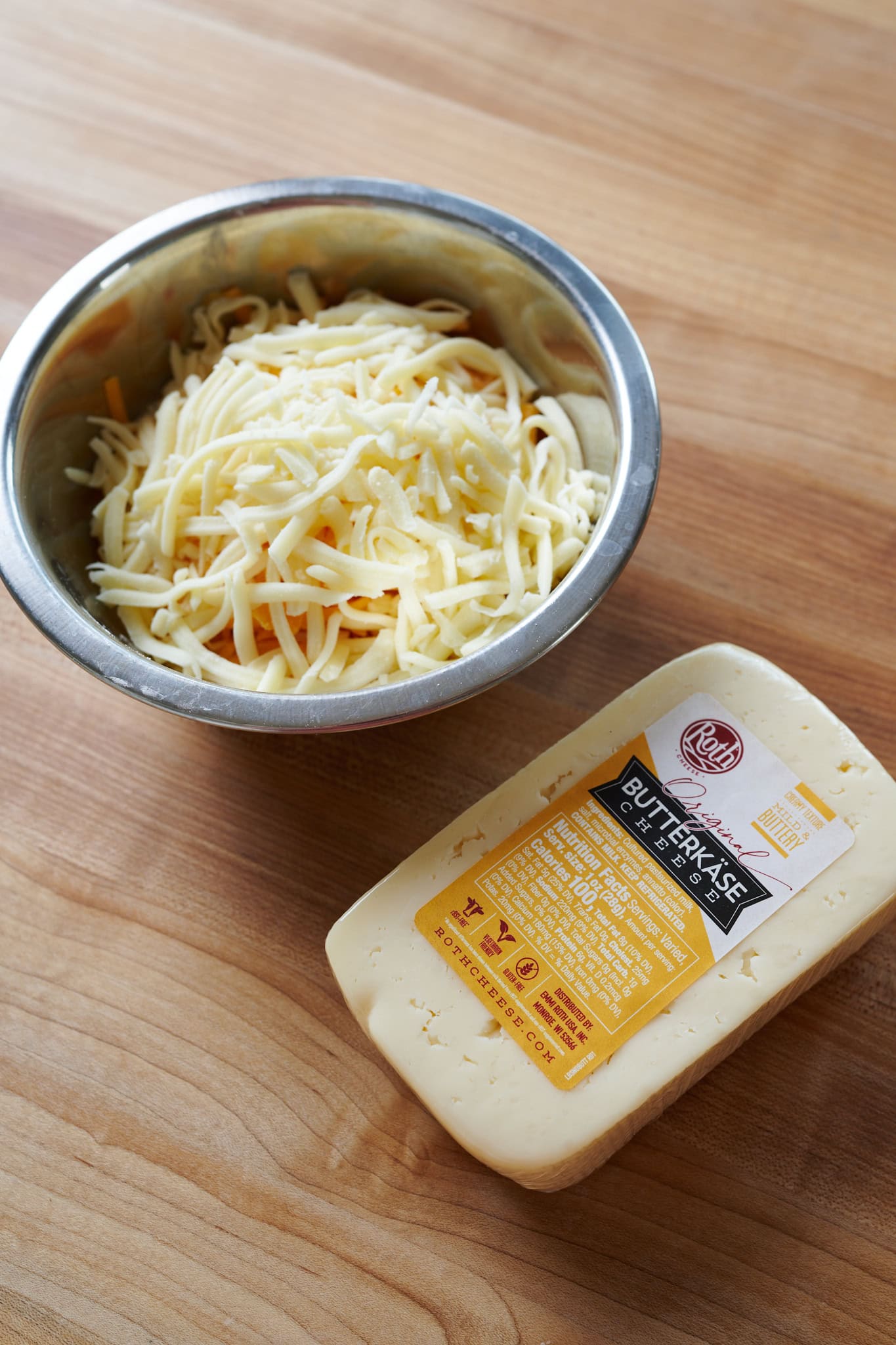
Topping Cheese: Butterkäse
Butterkäse means “butter cheese” in German, and this semi-soft cow’s milk cheese certainly has those buttery rich vibes, especially when melted on top of the pizza. It has a delicate flavor profile and has a very slight tang, similar to Wisconsin brick. Additionally, it melts wonderfully, providing even coverage and minimal pooling or liquefying.
The fantastic thing about this cheese is that it was easy to find at my local market! For me and my Detroit-style pizza, this will be my go-to cheese.
Topping Cheese: Make Your Own Blend
If you can’t find Wisconsin brick or butterkäse cheeses, a suitable blend would be a 50/50 combination of whole milk mozzarella and cheddar, or even better, Monterey Jack (which has a little more tang to it).
Cheese Crust
What is a Frico Crust?
A distinctive feature of Detroit-style pizza is the deeply caramelized cheese edge that forms around the rectangular pizza during baking. This golden, crispy, and incredibly flavorful “frico crust” is formed by cheese along the perimeter melting against the metal pan during baking.
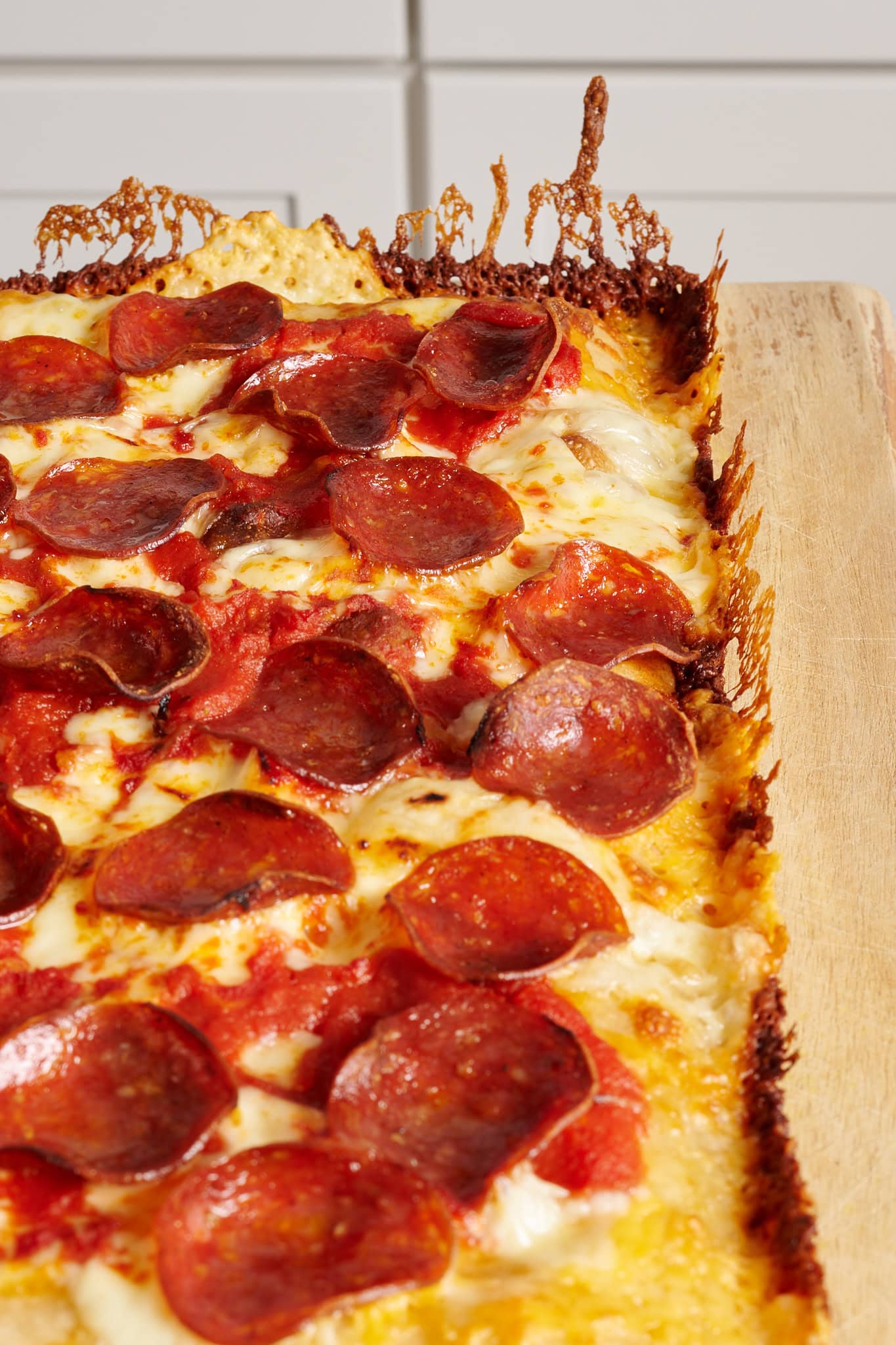
Interestingly, frico is an Italian dish from Friuli-Venezia, a region in northeast Italy. It’s similar to the Swiss rösti, which is often made from potatoes. In Italy, it’s often made with heated and melted cheese until the cheese turns lacey and crispy.
What is the Best Cheese For a Frico Crust?
The best cheese for making a crispy and sturdy frico crust on pizza is pre-shredded cheese. I’ve been using a mixture of shredded mozzarella and yellow cheddar cheese for maximum flavor and just the right level of crispiness. It helps if the shredded cheese is slightly thicker, not finely shredded.
Alexandra mentions in her book that pre-shredded cheese is the best to form a frico crust due to the starches present in pre-shredded cheese packs. I tested this and found it to be absolutely true: if you shred your cheese from a large block, it melts too fast, becoming a liquid cheese that pools rather than stands tall.
Detroit-Style Pizza Sauce
With my sourdough pizza, I usually use a simple sauce that’s not cooked for a fresh and bright tomato flavor. But, this Detroit-style pizza calls for cooked tomato sauce to be traditional and for a slightly different flavor profile—more intense, herby, and a little punch of garlic.
I followed Alexandra’s recipe for her Simple Tomato Sauce. See the recipe steps below for instructions on making her cooked tomato sauce.
The Best Pan for Detroit-Style Pizza
Since Detroit-style pizza is much thicker, it needs a deeper pan. Hands down, the best pan for making this type of pizza I’ve tested with is the 10 x 14-inch LloydPans Detroit Style Pizza Pan. This Detroit-style pizza pan is made of hard-anodized aluminum, is practically nonstick, does not require seasoning, and conducts heat incredibly efficiently for a crispy crust every time.
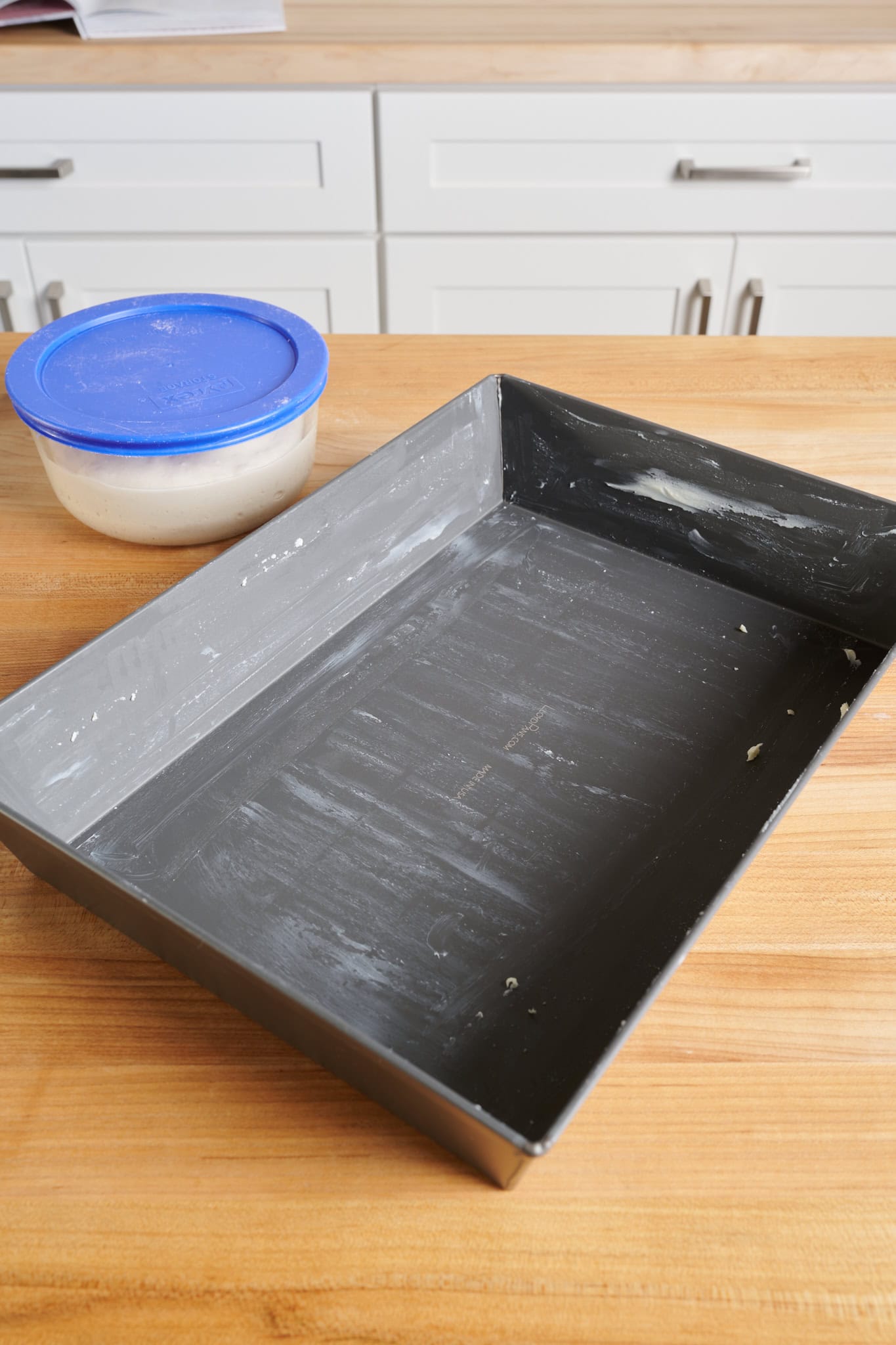
I’ve been baking with LloydPans (like with my focaccia pugliese) in my kitchen for many years, and they’ve slowly replaced all my baking sheets and other pizza pans. I also love that they’re made in the USA by a small company dedicated to quality.
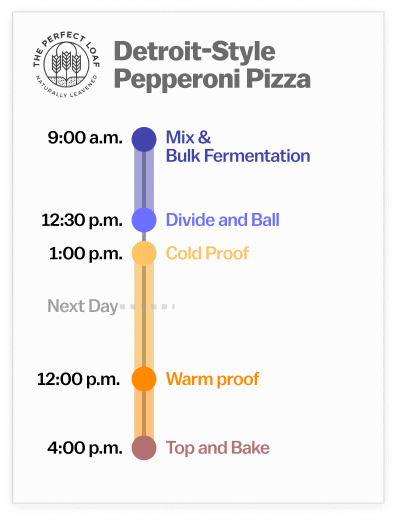
Baking Schedule
This recipe can be made all in a single day (direct dough) or split over two days (cold proofed). I’ll show the two-day process, which I find brings more flavor and is much more flexible in terms of timing.
If you want to bake this pizza the same day you mix it, instead of balling the dough and cold-proofing it, divide it and place it directly into the pizza pan (you can ball one half of the dough and refrigerate it for later). Then, follow the instructions after I remove the dough from the fridge and put it in the pan.
A Look Into My Detroit-Style Pizza Dough Creation
I took Alexandra’s recipe as inspiration and, as she mentions in the book, used my sourdough focaccia dough recipe as the base of this pizza, but then modified it to be similar to her yeasted dough recipe.
Here’s how I modified my sourdough focaccia recipe for this pizza:
- Scaled up the dough to 600g per pizza for a slightly thicker pie (and to better support the toppings)
- Increased the dough hydration (76 to 78%) for a lighter and fluffier dough
- Increased the salt percentage significantly (Focaccia is topped with coarse salt before baking, so the salt percentage in the dough is low. Increasing the dough’s salt percentage aligns it more with a typical pizza dough.)
- Used 100% high-protein white flour (instead of a mix of AP and high-protein) for more structure and chew
- Removed the olive oil from the dough because extra tenderness isn’t needed
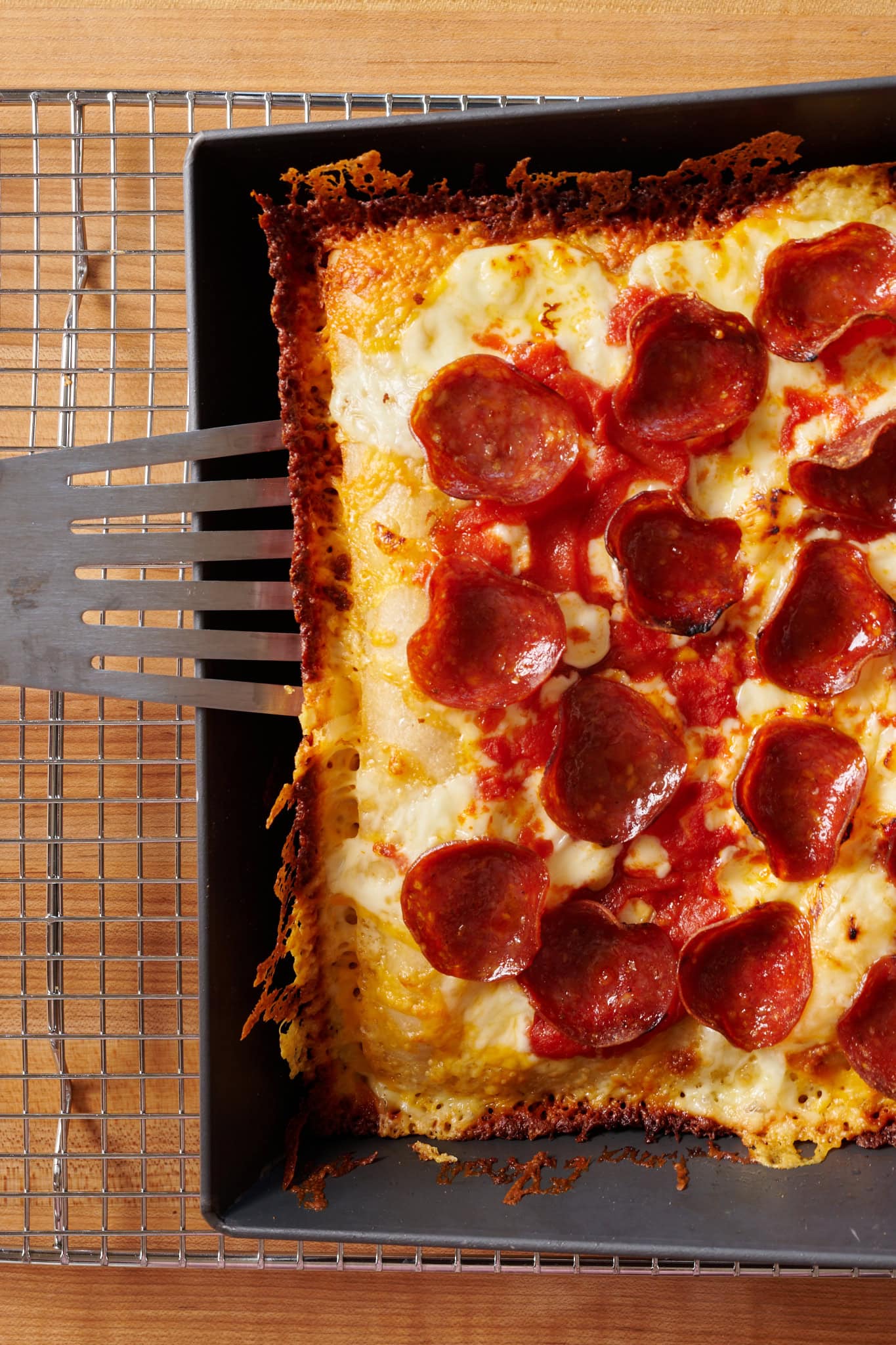
Detroit-Style Pizza Dough Formula
Vitals
This Detroit-style pizza dough formula makes two pizzas. If you’d like to make only a single pizza, halve all of the ingredients (as explained in my guide to baker’s percentages).
| Total Dough Weight | 1200 grams |
| Hydration | 78.0% |
| Pre-fermented Flour | About 8.9% (flour in sourdough starter) |
| Yield | Two 10 x 14-inch Detroit pizzas |
Total Formula
Desired dough temperature: 78°F (25°C). See my post on the importance of dough temperature for more information on dough temperatures.
| Weight | Ingredient | Baker’s Percentage |
|---|---|---|
| 600g | High-protein white bread flour (King Arthur Baking Bread Flour) | 100.0% |
| 469g | Water | 78.0% |
| 16g | Fine sea salt | 2.7% |
| 114g | Ripe sourdough starter | 19.0% |
Additional Ingredients
1 tablespoon extra-virgin olive oil, for the pan
2 tablespoons unsalted butter, at room temperature, for the pan
Pizza Toppings
| Weight | Ingredient |
|---|---|
| 113g | Pre-shredded cheddar (mild or sharp) |
| 57g | Pre-shredded mozzarella cheese (low moisture, whole milk) |
| 170g | Freshly cubed butterkäse, Wisconsin brick, or a mix of Monterey Jack and Mozzarella |
| Pepperoni (natural casing is best) to cover |
Simple Cooked Tomato Pizza Sauce
| Ingredient |
|---|
| ¼ cup extra-virgin olive oil |
| 2 cups finely chopped white or yellow onion |
| 3 garlic cloves, minced |
| Kosher salt |
| Pinch of crushed red pepper flakes |
| ½ cup white wine |
| 1 (28-ounce) can undrained peeled whole San Marzano tomatoes (I like Bianco DiNapoli) |
| ½ cup packed fresh basil leaves |
Detroit-Style Pizza Dough Method
1. Mix – 9:00 a.m.
| Weight | Ingredient |
|---|---|
| 600g | High-protein white bread flour |
| 469g | Water |
| 16g | Fine sea salt |
| 114g | Ripe sourdough starter |
I like to mix this dough in my KitchenAid stand mixer, but you could use a larger bread dough mixer or mix this dough by hand.
Using a Stand Mixer
To the bowl of a stand mixer, add the flour, water, salt, and ripe sourdough starter. Mix on speed one for 1 to 2 minutes until the dough comes together, and no dry bits remain. Then, turn the mixer up to speed two and mix for 5 minutes.
Let the dough rest in the mixing bowl for 10 minutes.
Then, turn the mixer to speed two and mix for 2 to 3 minutes until the dough is cohesive.
Mixing By Hand
To a large mixing bowl, add the flour, water, salt, and ripe sourdough starter. Using a dough whisk or wet hand, mix the ingredients together until they form a shaggy mass. then, using a wet hand, reach down into the bowl on one side and stretch the dough up and over. rotate the bowl and perform this stretching and folding action again. Repeat for 3 to 5 minutes until the dough smooths a bit and loses some shagginess.
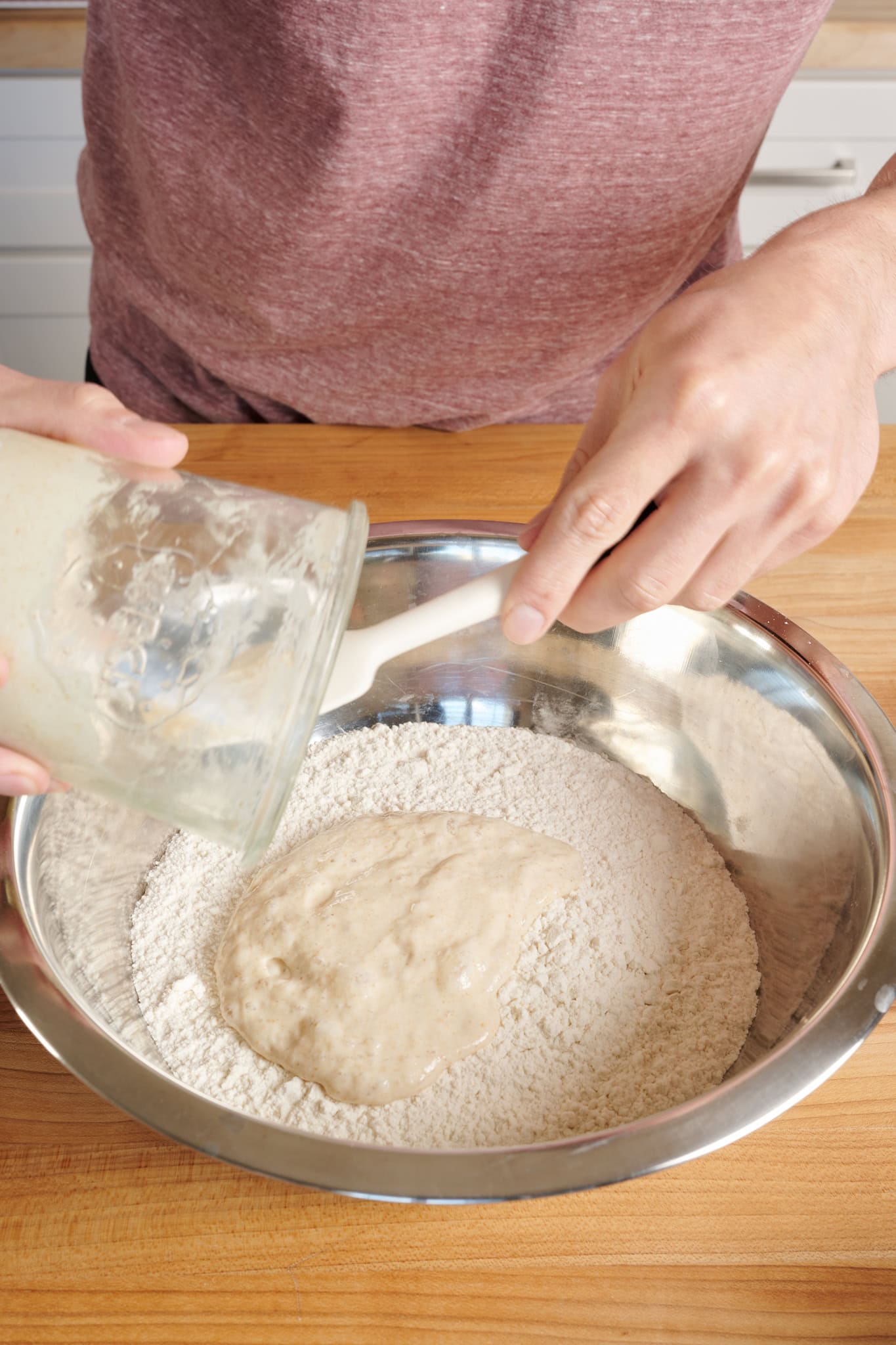
At the end of mixing, the dough will be smoother but still very soft and slack. It should not be soupy or excessively wet (if it is, add a little bit of flour and mix it in). Transfer the dough to a container for bulk fermentation and cover.
2. Bulk Fermentation – 9:30 a.m. to 12:30 p.m.
At warm room temperature, around 74-76°F (23-24°C), bulk should take about 3 hours. This dough needs four sets of stretch and folds, spaced out by 30 minutes during this time.
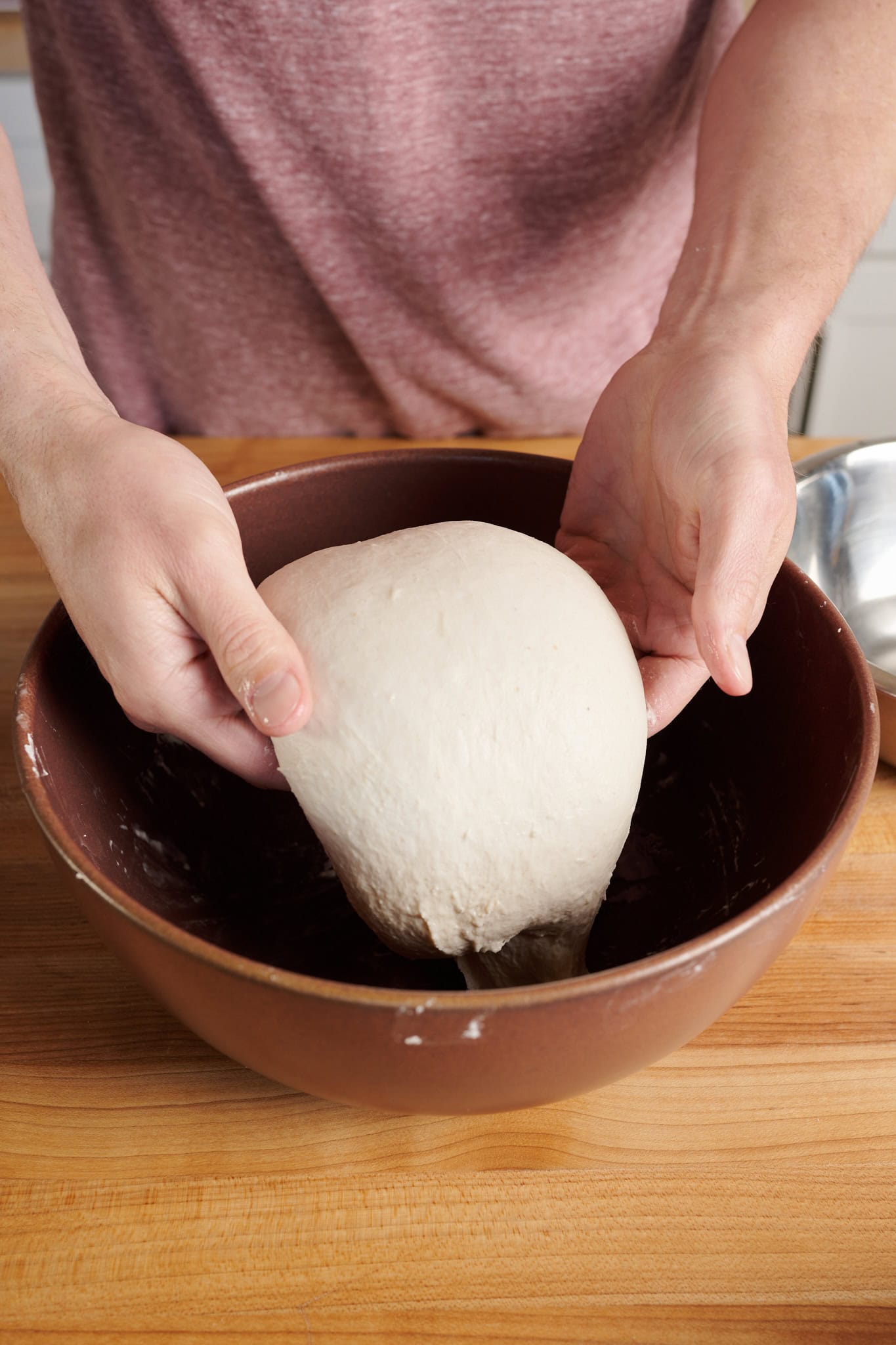
This is a wet and extensible dough, so I like to give it four sets of vigorous stretch and folds. After the first 30 minutes in bulk fermentation and using wet hands, grab the north side of the dough in the bulk fermentation container and stretch it up and over to the south side. Then, grab the south side of the dough and stretch it up and over to the north side. Repeat in the east-to-west and west-to-east directions for a total of 4 folds.
Give the dough three more sets of stretch and folds at 30-minute intervals. After the last set, let the dough rest in the container until the end of bulk fermentation.
3. Divide and Ball – 12:30 p.m.
Grease a pizza dough tray or two individual 4-cup glass containers with olive oil.
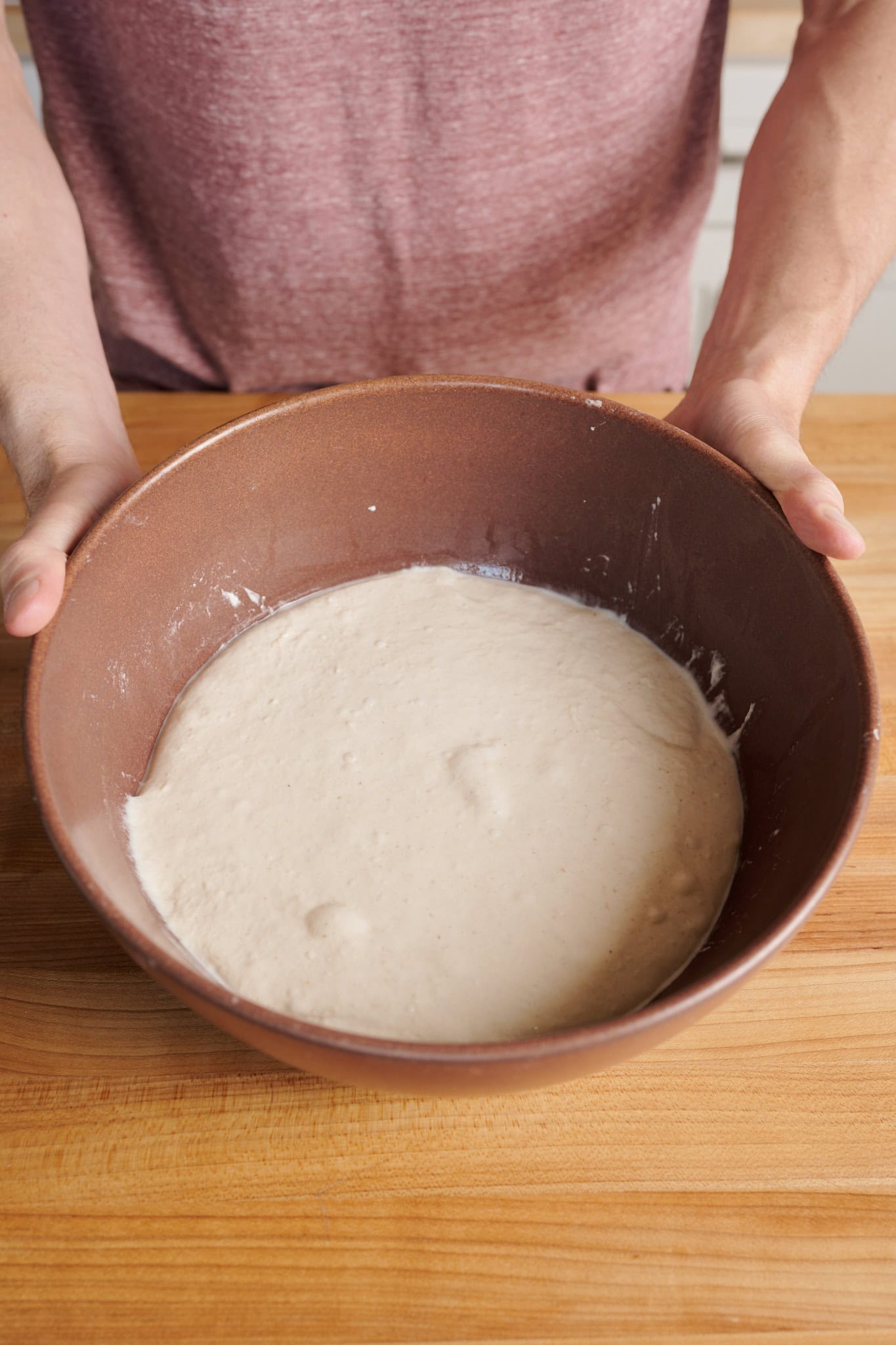

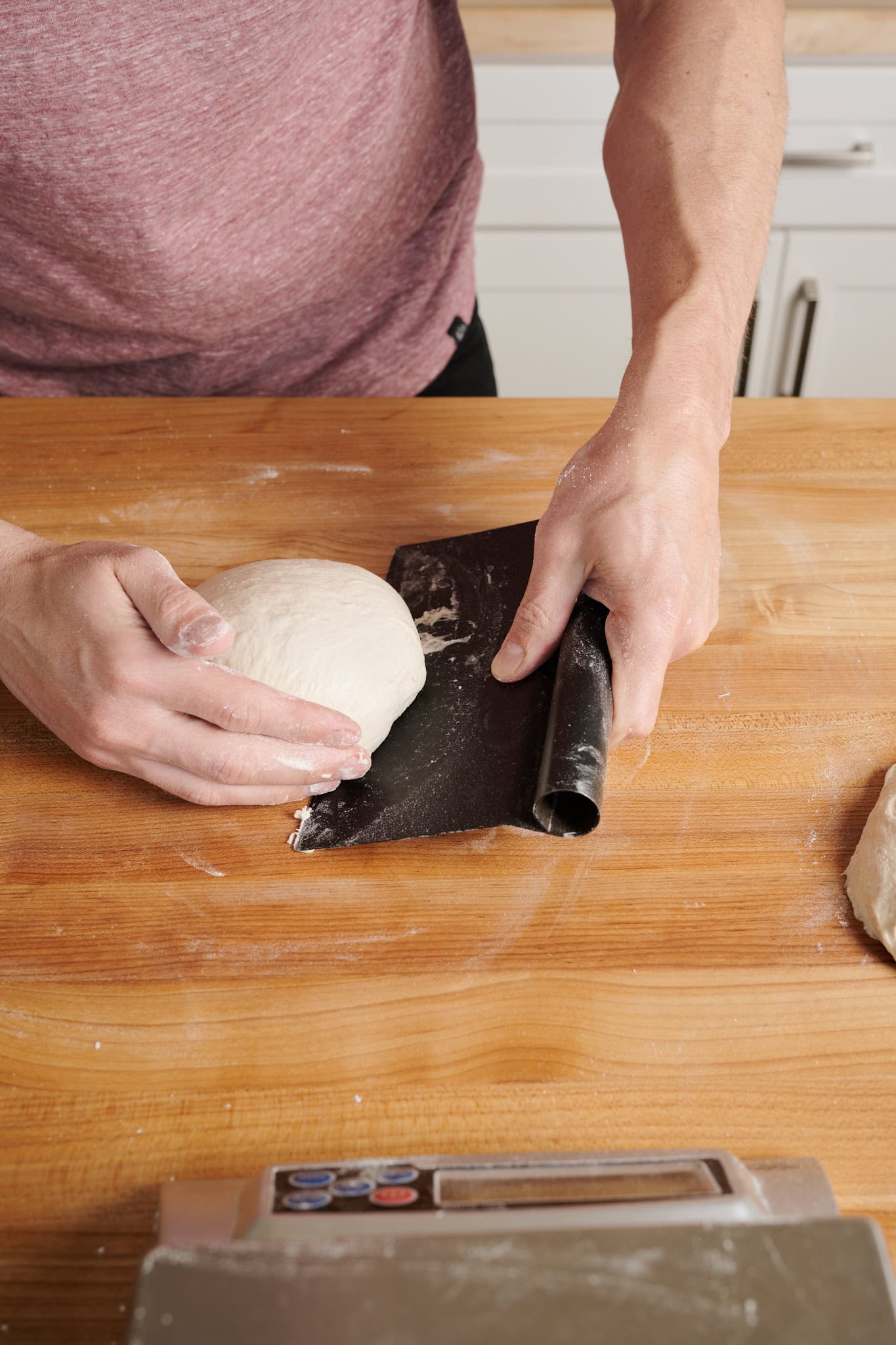
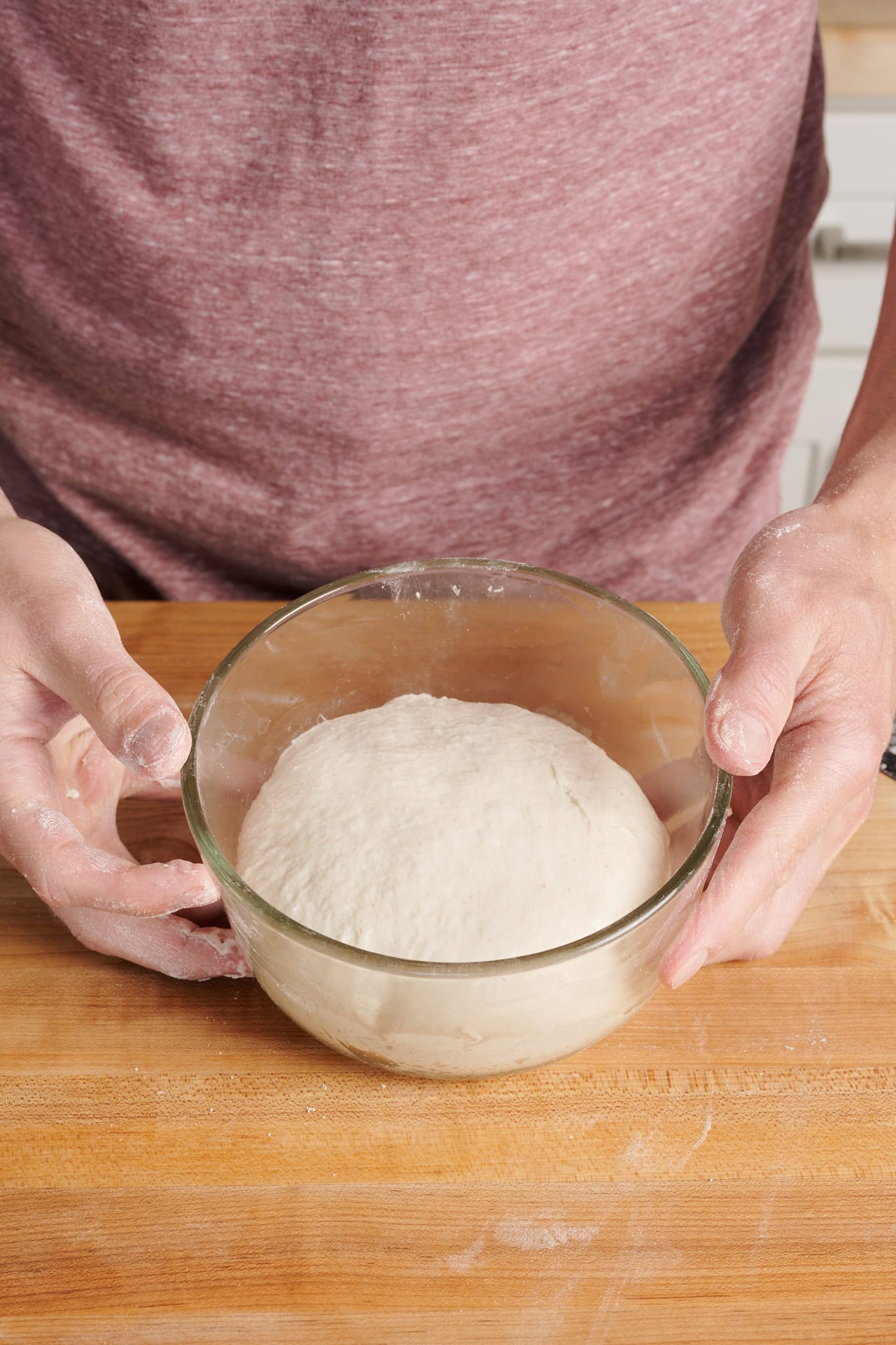
Gently scrape the dough out to a clean work surface. Using floured hands, divide the dough in half. Preshape each piece into a very tight ball with no seam on the bottom. Given how highly hydrated this dough is, I like to preshape this dough on the work surface using a bench knife, similar to preshaping bread dough. After balling, place each ball into the prepared dough tray with even spacing between, or into a single container.
4. Cold Proof – 1:00 p.m. to 12:00 p.m. (the next day)
Place the containers into the refrigerator overnight or for up to 3 days.
5. Warm Proof – 12:00 p.m. to 4:00 p.m.
The next day, liberally butter a 10 x 14-inch Detroit-style pizza pan with about 1 tablespoon of butter. According to Alexandra, the butter helps the dough color better on the sides and bottom, but also helps it remove cleanly from the sides of the pan when baking.
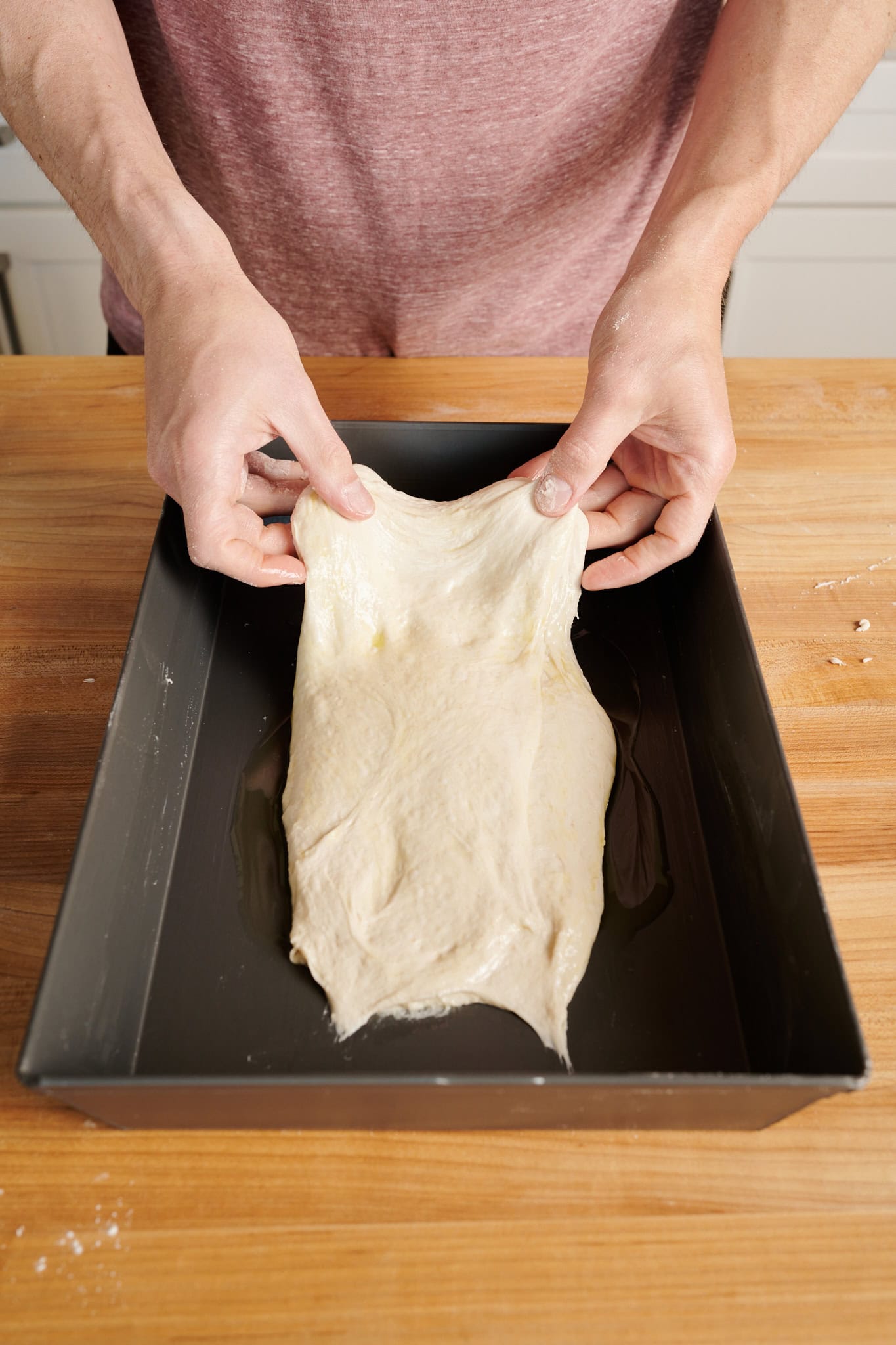
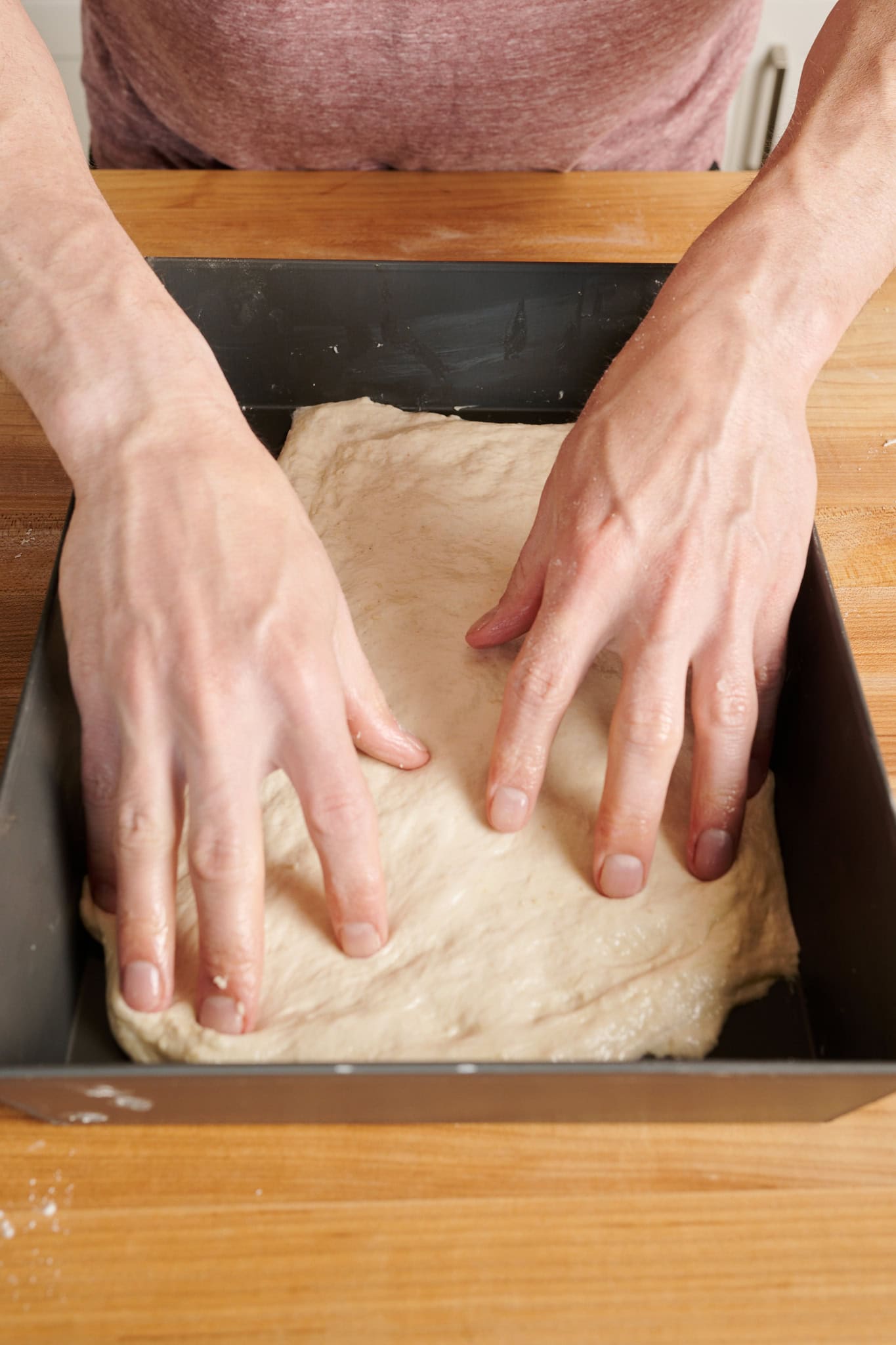
Pour a glug of olive oil into the center of the pan, take one container of dough out of the fridge, uncover, and gently scrape it out on top of the oil. Using wet or oiled fingers, flip the dough over to coat the other side in olive oil, and gently stretch it out to better fit the dimensions of the pan. It’s okay if the dough doesn’t completely stretch out.
You can leave the second dough ball in the fridge for up to 2 days.
Cover the dough and set a timer for 1 hour. After an hour, come back and, with wet fingers, gently stretch the dough a little further toward the edges.
While the dough is proofing, prepare the sauce.
6. Prepare Tomato Sauce – 3:30 p.m.
| Ingredient |
|---|
| ¼ cup extra-virgin olive oil |
| 2 cups finely chopped white or yellow onion |
| 3 garlic cloves, minced |
| Kosher salt |
| Pinch of crushed red pepper flakes |
| ½ cup white wine |
| 1 (28-ounce) can undrained peeled whole San Marzano tomatoes (I like Bianco DiNapoli) |
| ½ cup packed fresh basil leaves (about ½ ounce) |
In a medium pot, combine the oil, onions, garlic, and a pinch of salt. Set over high heat and as soon as the onions and garlic begin simmering, stir, reduce the heat to low, cover, and cook for 10 minutes.
Uncover, stir in the pepper flakes, increase the heat to high, and add the wine. Simmer for 2 to 3 minutes to dissipate the alcohol. Using scissors, snip the tomatoes into smaller pieces as you add them to the pan. Season with a generous pinch of salt and cook at a gentle simmer for 15 minutes.
Transfer the sauce to a blender or food processor, add the basil, and puree until smooth (if using a blender, be sure to let the mixture cool before blending). Taste and adjust with more salt if needed. Store in the fridge for up to 1 week or in the freezer for up to 3 months.
7. Top and Bake – 4:15 p.m.
About an hour before the end of proofing proof, begin preheating your oven with a rack in the middle to 500°F (260°C) and with a baking surface—I like to use my Baking Steel—inside on the rack.
Once your baking surface is preheated, baking this sourdough Detroit-style pizza is done in two phases:
Step 1: Parbake Dough
Using oiled fingers, dimple the dough aggressively but try to steer clear of perimeter (leave about a 1/2-inch border).
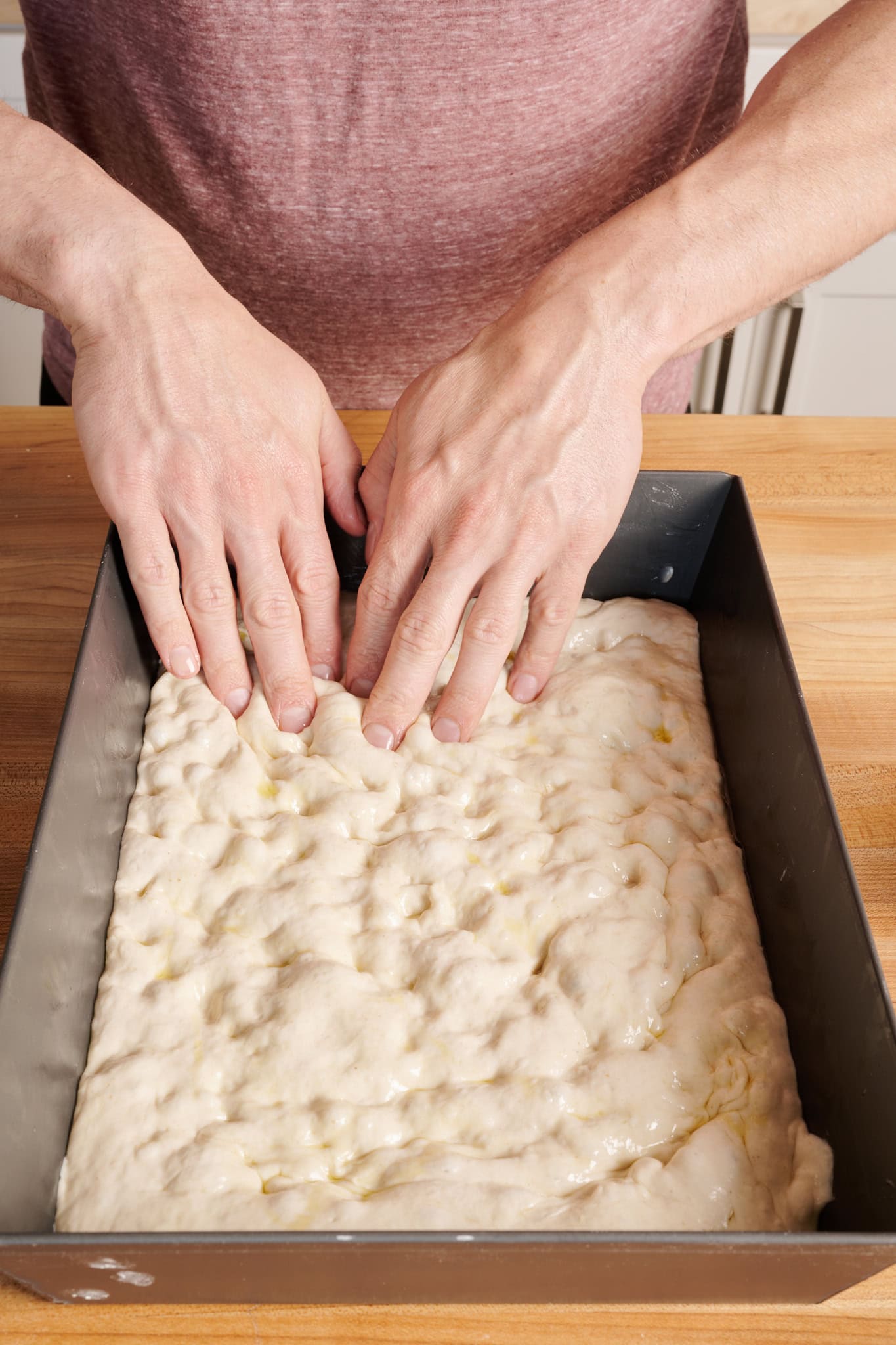
Slide the pan onto the baking surface and bake until the dough has puffed, slightly removed from the sides, and the top is lightly colored, about 8 to 10 minutes. Remove the pan from the oven and using an offset or fish spatula, remove the parbaked crust to a wire rack.
Parbaking helps the crust shrink a bit, as you can see below. This will give us room to sneak in some (okay, a lot) of cheese around the edge to form the frico crust.
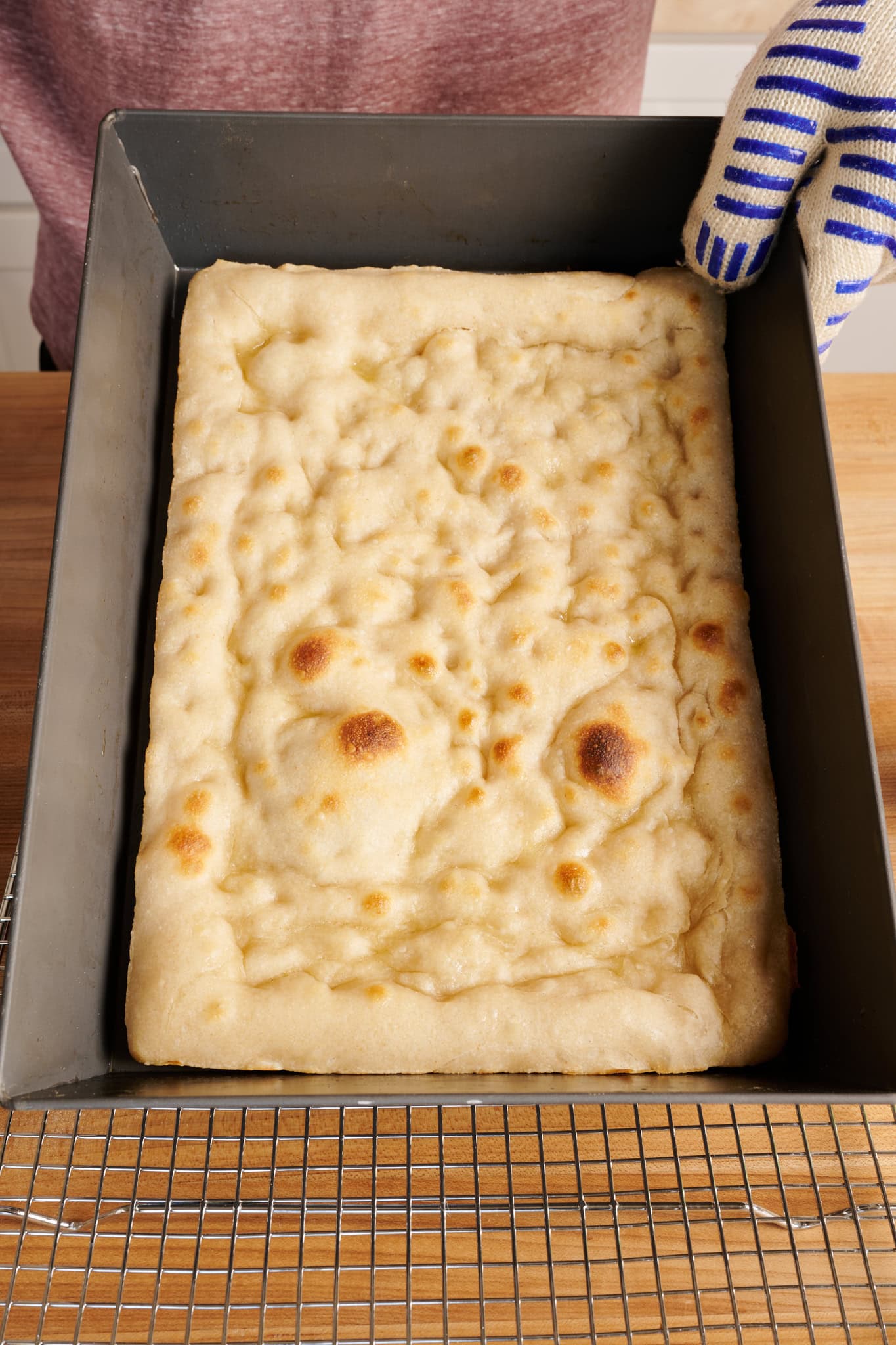
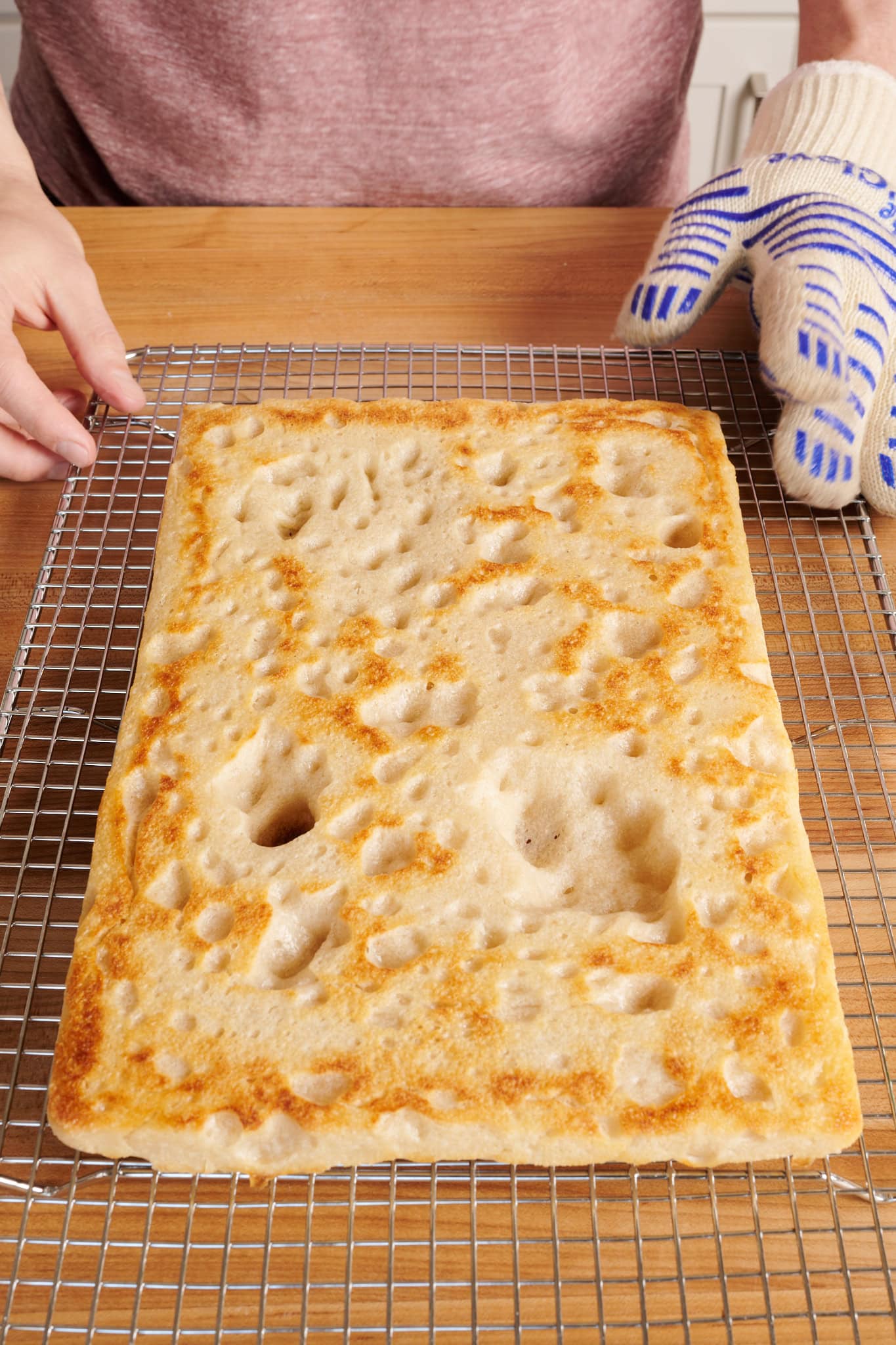
Flip the crust so the top is facing down on the wire rack and leave it to cool for 20 minutes. Don’t clean the pan, we’ll be using that again soon.
Reduce the oven temperature to 475°F (245°C).
Step 2: Spread Toppings and Finish Baking.
In a medium bowl, combine the shredded cheddar and mozzarella and cube the butterkäse or Wisconsin brick cheese. Place the crust back into the pan bottom-side down.
To make the frico crust, spread the shredded cheese mixture around the perimeter of the crust. I like to lean it against the metal to get as much height as possible.
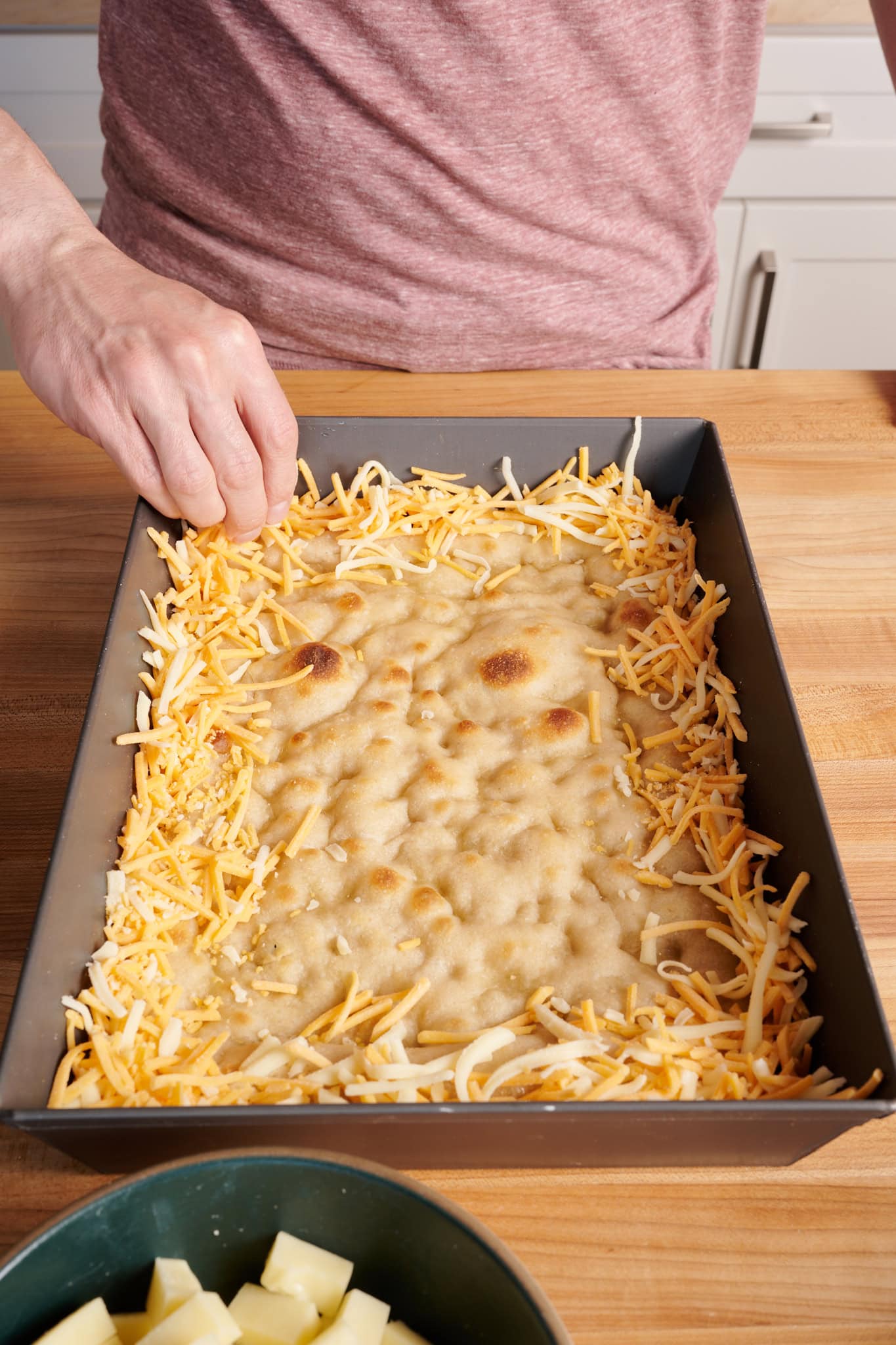
Next, spread the cubed cheese over the surface of the crust inside the shredded cheese perimeter. Then, dollop and spread 1/2 cup of the tomato sauce (it will not feel like enough sauce, but trust me, it is) evenly over the top. Finally, spread the pepperoni over the sauce.
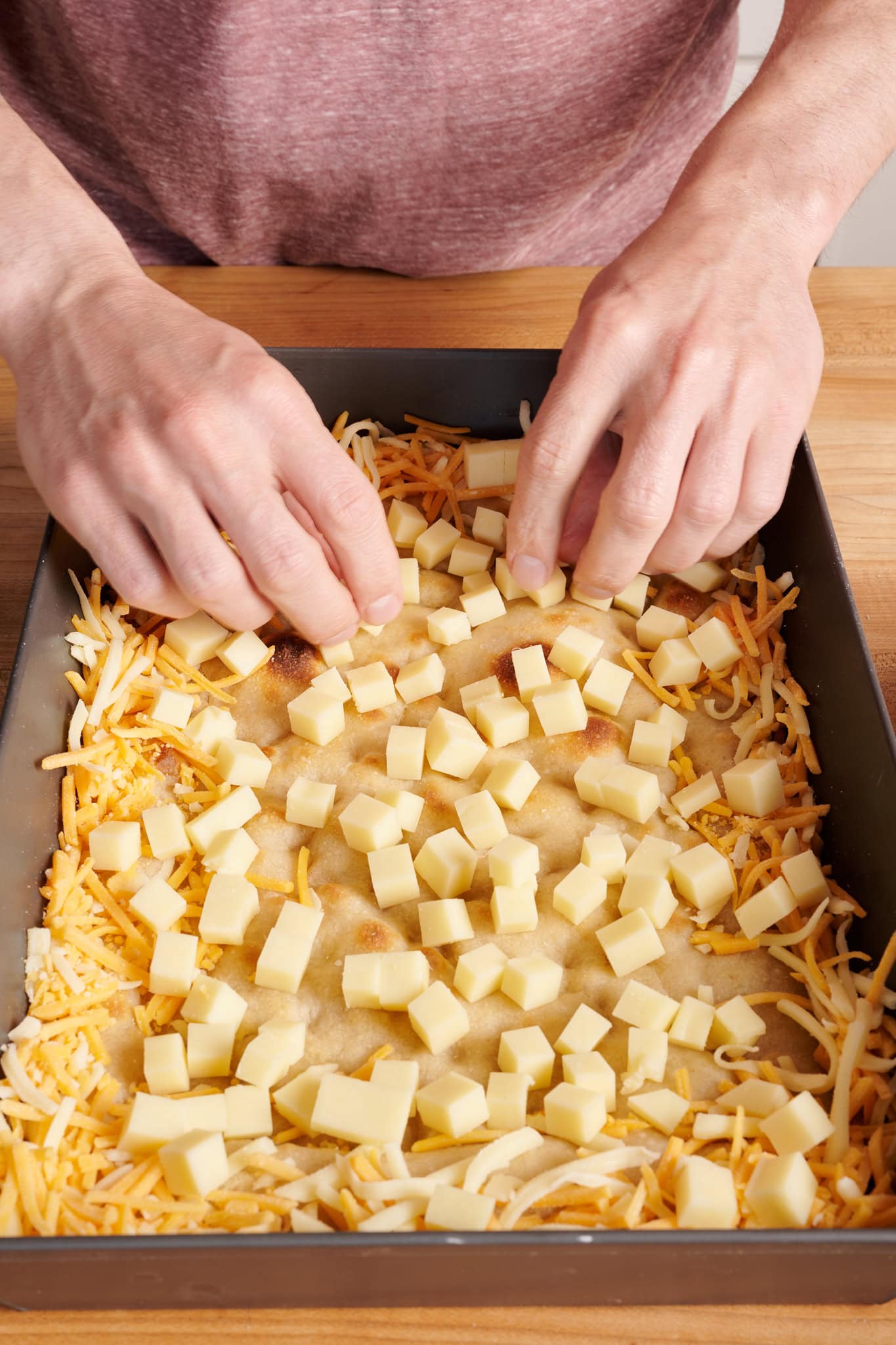

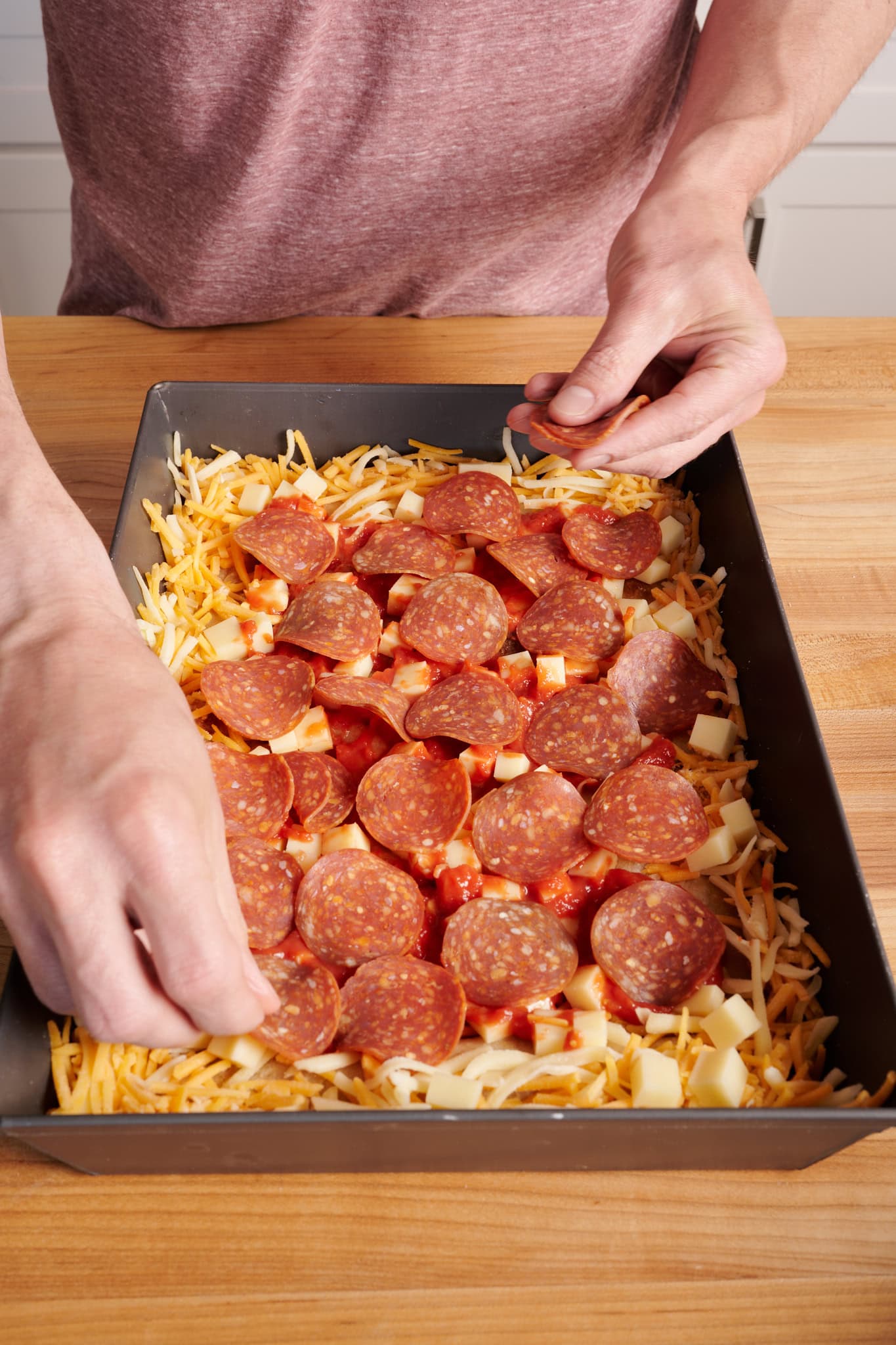

Slide the pan into the oven on top of the baking surface and bake until the edges are crispy and caramelized, about 10 to 15 minutes. For me at high altitude, it took a full 15 minutes for the cheese to be fully melted and singed, and the crust to be ultra-crispy.
Remove the pan from the oven and let the pizza rest on a wire rack for 5 minutes. Carefully run a thin metal spatula around the edges to release the crust and transfer the pizza to a cutting board and cut with a pizza wheel (or the fantastic LloydPans mezzaluna pizza rocker knife).
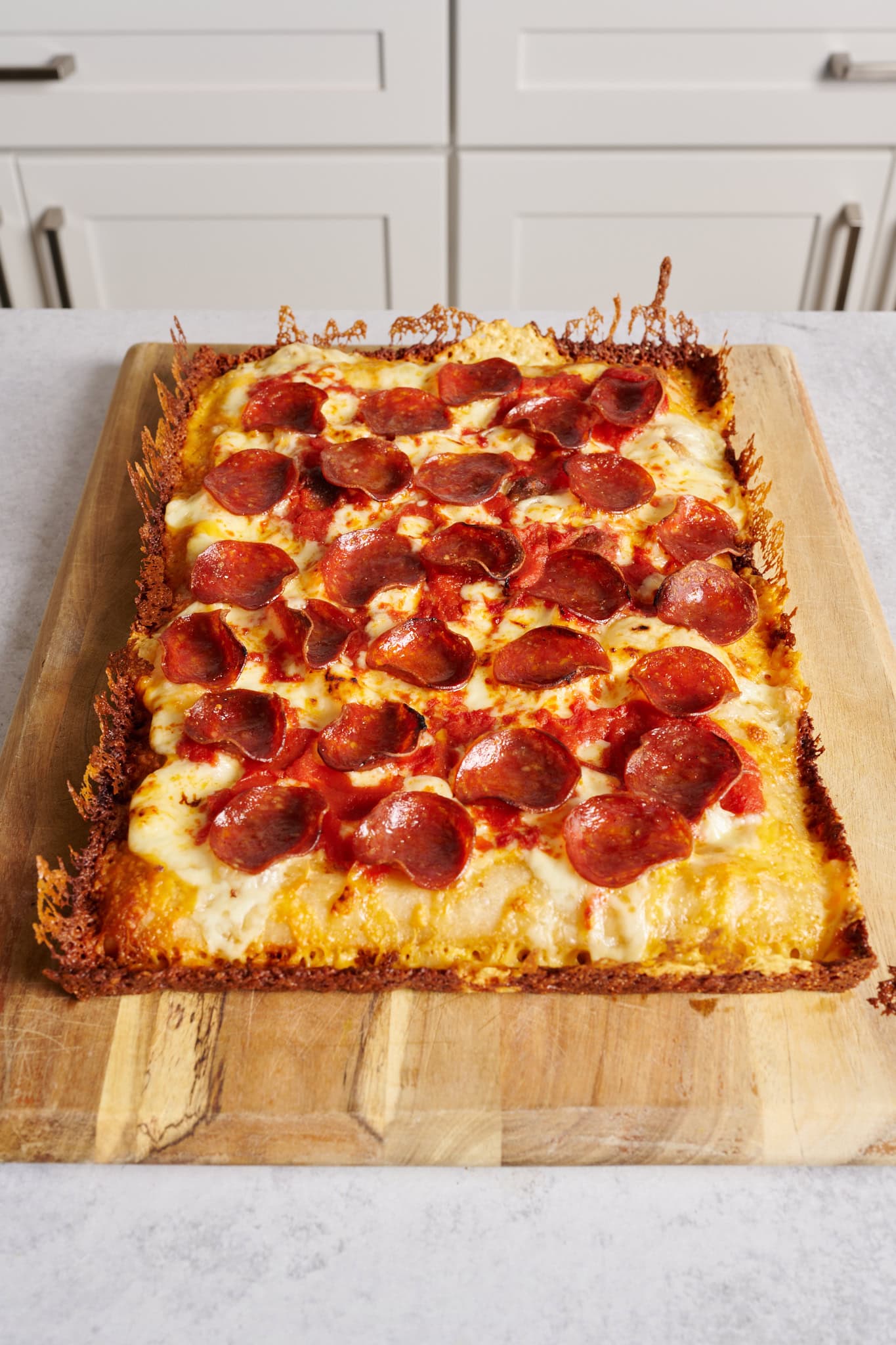
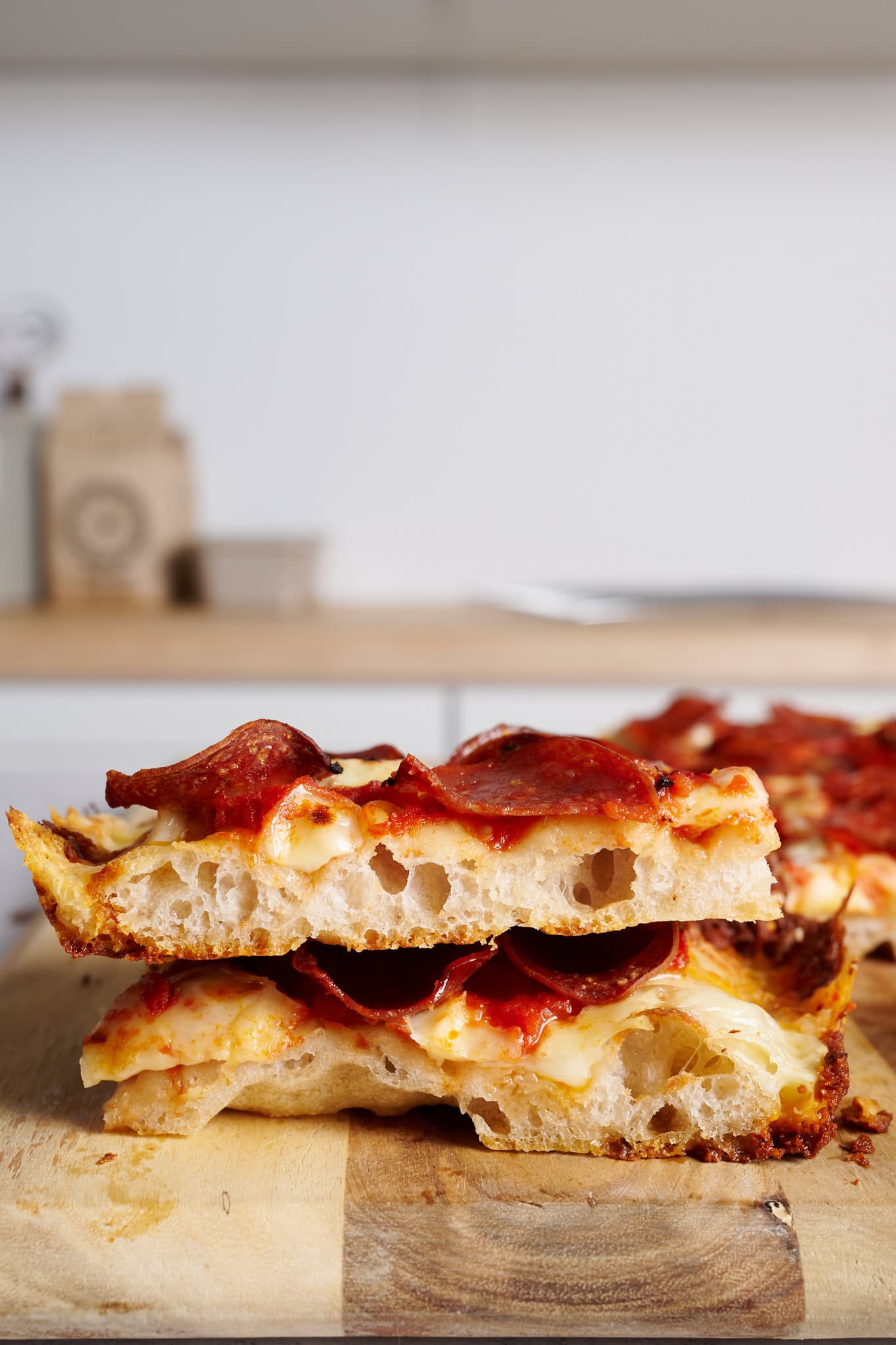

Sourdough Detroit-Style Pepperoni Pizza
- Author: Maurizio Leo
- Prep Time: 32 hours
- Cook Time: 45 minutes
- Total Time: 32 hours 45 minutes
- Yield: 2 pizzas
- Category: Lunch, Dinner
- Cuisine: American, Italian
Description
A thick, cheesy, chewy, and wonderfully tasty rectangular pizza with a cheese frico (crispy) crust.
Adapted from Alexandra Stafford’s Pizza Night.
Ingredients
Dough
- 600g high-protein white bread flour
- 469g water
- 16g fine sea salt
- 114g ripe sourdough starter
Toppings
- 113g pre-shredded cheddar cheese (mild or sharp)
- 57g pre-shredded mozzarella cheese (low moisture, whole milk)
- 170g freshly cubed butterkäse, Wisconsin brick, or a mix of Monterey Jack and Mozzarella cheese
- Pepperoni to cover
Simple Cooked Tomato Sauce
- 1/4 cup extra-virgin olive oil
- 2 cups finely chopped white or yellow onion
- 3 garlic cloves, minced
- Kosher salt
- pinch of crushed red pepper flakes
- 1/2 cup white wine
- 1 (28oz) can undrained peeled whole San Marzano tomatoes
- 1/2 cup packed fresh basil leaves
Instructions
- Mix – 9:00 a.m.
To the bowl of a stand mixer, add the flour, water, salt, and ripe sourdough starter. Mix on speed one for 1 to 2 minutes until the dough comes together, and no dry bits remain. Then, turn the mixer up to speed two and mix for 5 minutes. Let the dough rest in the mixing bowl for 10 minutes. Then, turn the mixer to speed two and mix for 2 to 3 minutes until the dough is cohesive. Transfer the dough to a container for bulk fermentation and cover. - Bulk Fermentation – 9:30 a.m. to 12:30 p.m.
At warm room temperature, around 74-76°F (23-24°C), bulk should take about 3 hours. After the first 30 minutes in bulk fermentation and using wet hands, grab the north side of the dough in the bulk fermentation container and stretch it up and over to the south side. Then, grab the south side of the dough and stretch it up and over to the north side. Repeat in the east-to-west and west-to-east directions for a total of 4 folds. Give the dough three more sets of stretch and folds at 30-minute intervals. After the last set, let the dough rest in the container until the end of bulk fermentation. - Divide and Ball – 12:30 p.m.
Grease a pizza dough tray or two individual 4-cup glass containers with olive oil. Gently scrape the dough out to a clean work surface. Using floured hands, divide the dough in half. Preshape each piece into a very tight ball with no seam on the bottom. Given how highly hydrated this dough is, I like to preshape this dough on the work surface using a bench knife, similar to preshaping bread dough. After balling, place each ball into the prepared dough tray with even spacing between, or into a single container. - Cold Proof – 1:00 p.m. to 12:00 p.m. (the next day)
Place the containers into the refrigerator overnight or for up to 3 days. - Warm Proof – 12:00 p.m. to 4:00 p.m.
The next day, liberally butter a 10 x 14-inch Detroit-style pizza pan with about 1 tablespoon of butter. Pour a glug of olive oil into the center of the pan, take one container of dough out of the fridge, uncover, and gently scrape it out on top of the oil. Using wet or oiled fingers, flip the dough over to coat the other side in olive oil, and gently stretch it out to better fit the dimensions of the pan. Cover the dough and set a timer for 1 hour. After an hour, come back and, with wet fingers, gently stretch the dough a little further toward the edges. - Prepare Tomato Sauce – 3:30 p.m. (while dough proofs)
In a medium pot, combine the oil, onions, garlic, and a pinch of salt. Set over high heat and as soon as the onions and garlic begin simmering, stir, reduce the heat to low, cover, and cook for 10 minutes. Uncover, stir in the pepper flakes, increase the heat to high, and add the wine. Simmer for 2 to 3 minutes to dissipate the alcohol. Using scissors, snip the tomatoes into smaller pieces as you add them to the pan. Season with a generous pinch of salt and cook at a gentle simmer for 15 minutes. Transfer the sauce to a blender or food processor, add the basil, and puree until smooth (if using a blender, be sure to let the mixture cool before blending). Taste and adjust with more salt if needed. - Top and Bake – 4:15 p.m.
About an hour before the end of proofing proof, begin preheating your oven with a rack in the middle to 500°F (260°C) and with a baking surface—I like to use my Baking Steel—inside on the rack. Using oiled fingers, dimple the dough aggressively, but try to steer clear of the perimeter (leave about a 1/2-inch border). Bake until the dough has puffed, slightly removed from the sides, and the top is lightly colored, about 8 to 10 minutes. Remove the pan from the oven and remove the parbaked crust to a wire rack. Flip the crust so the top is facing down on the wire rack and leave it to cool for 20 minutes. Reduce the oven temperature to 475°F (245°C). In a medium bowl, combine the shredded cheddar and mozzarella and cube the butterkäse or Wisconsin brick cheese. Place the crust back into the pan bottom-side down. Spread the shredded cheese mixture around the perimeter of the crust. Next, spread the cubed cheese over the crust’s surface inside the shredded cheese perimeter. Then, dollop and spread the sauce evenly over the top. Finally, spread the pepperoni over the sauce. Bake until the edges are crispy and caramelized, about 10 to 15 minutes. Remove the pan from the oven and let the pizza rest on a wire rack for 5 minutes. Carefully run a thin metal spatula around the edges to release the crust and transfer the pizza to a cutting board and cut.
Notes
The parbaked pizza crust can be cooled, placed into a large airtight bag, and kept at room temperature for up to 2 days or 3 months in the freezer.
Detroit-Style Pizza FAQs
Can I cold-ferment Detroit pizza dough?
Yes. After bulk fermentation, divide and ball the dough and place it into an oiled and sealed container. Place the container into the refrigerator for 1 to 3 days.
What is the best pan for Detroit-style Pizza?
A steel or blue steel rectangular pan is best for Detroit-style pizza. A steel pan conducts heat efficiently and results in a crisp, golden crust.
How thick is Detroit-style pizza?
Detroit-style pizza is thicker than Sicilian-style pizza but thinner than grandma-style pizza (and much thinner than Chicago-style pizza).
What’s the Difference Between Detroit-style Pizza and Sicilian Pizza?
While both pizza types are rectangular and thick, Sicilian pizza is usually baked on a shallower sheet pan versus the deep blue steel pan used for Detroit-style pizza. This results in a Sicilian pizza crust being denser, sturdier, and more bread-like. Additionally, many Sicilian pizza doughs include semolina (durum) flour, commonly used in Italy for pasta, bread, and pizza.
Can I freeze this pizza dough?
Yes, you can. After balling the dough and placing into the proofing container, place it into the freezer for up to 3 months. Note I find that while this works, the resulting pizza doesn’t rise quite as high. Instead, I much prefer freezing the parbaked crust.
What’s Next?
Go get Alexandra Stafford’s cookbook Pizza Night and revel in the glory that is pizza every week of the year. It’s a life I certainly want to live.
If you need more help with sourdough pizza, drop by The Perfect Loaf’s ultimate guide to pizza for help with dough preparation, ingredient sourcing, recipe inspiration, and more.
Buon appetito! 🍕
“Pizza Night” Copyright © 2024 by Alexandra Stafford. Published by Clarkson Potter, an imprint of Crown Publishing.”


